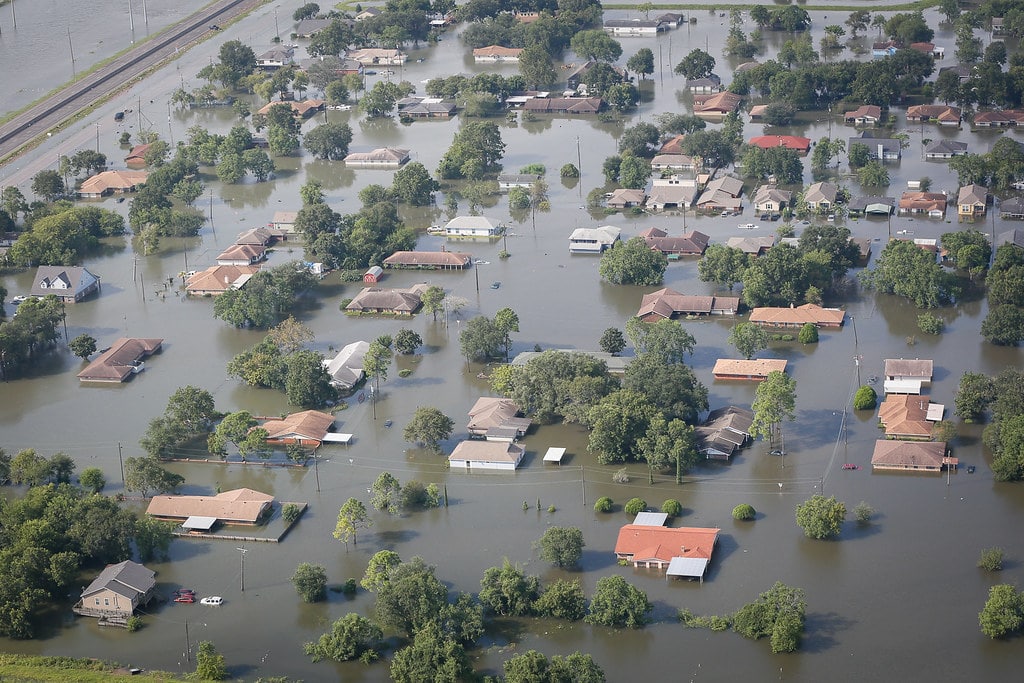Climate change is a global phenomenon with terrifying environmental implications escalating right before our eyes. Irresponsible human activities such as fossil fuel burning are causing more frequent natural disasters such as hurricanes and floods. When such extreme weather phenomena hit vulnerable chemical facilities, such as those located in low-lying coastal areas, they can result in flood water contamination if a hazardous substance leak occurs. Exposure to toxic floodwaters can have life-threatening health effects on those living near the affected chemical plant. Some private law mechanisms have been implemented to prevent such incidents from happening as well as to protect people at risk. But how effective are they really?
—
Climate change is real and undeniable. Global sea levels have risen approximately 8 inches during the last century and the average surface temperature of the planet has increased 2° Fahrenheit (1.1C) above pre-industrial levels. And within the last few decades, increasingly more tragic natural disasters have struck the United States, leading to flood water contamination.
In August 2017, Hurricane Harvey hit Texas and Louisiana, causing 68 direct fatalities, 39 indirect fatalities, 21 injuries and forced 200 people within 1.5 miles (2.4 kilometres) of the Arkema chemical facility in Crosby, Texas, to leave the area. The cause for their evacuation was that over three feet of flooding disabled the refrigeration system of the plant, leading to organic peroxides spontaneously combusting. Furthermore, the flooding carried over 2,200 pounds of chromium and 1,433 pounds of nickel from sites around Houston into the nearby Galveston Bay.
Over 3,200 of the 10,420 Risk Management Plan (RMP) facilities across the United States, including hundreds of chemical facilities, are at risk of leaking dangerous chemicals into the environment and among the communities residing in close proximity if natural disasters triggered by climate change strike. There are currently 872 chemical facilities within 50 miles of the Gulf Coast, an area prone to hurricanes. Nearly 4.4 million people live within 1.5 miles of these chemical plants, as well as 1,717 schools and 98 medical facilities.
How Prepared Are Vulnerable Chemical Facilities to Respond to a Natural Disaster?
The RMP rule makes it mandatory for facilities that use or store hazardous substances to develop plans that identify the potential consequences of a chemical accident, come up with effective prevention steps, and think of appropriate emergency responses. Even though RMP facilities are instructed to consider all possible causes of emergencies, a report by the Government Accountability Office found that risks stemming from climate change were not taken into account, which leaves these facilities with scarce information and direction on how to handle threats such as hurricanes and sea level rise. The report discovered that over 150 facilities are located in areas that may experience at least one foot (0.3 metres) of sea level rise.
After a big explosion at a Texas fertiliser plant in 2013 that occurred partly because of a lack of federal regulations on how certain hazardous chemicals must be stored, former US President Barack Obama requested the Environmental Protection Agency (EPA) to review the risk management planning regulations and decide whether they should be expanded. Eventually, the EPA published a major update to these rules that would oblige tens of thousands of industrial facilities to evaluate their potential chemical spill effects and develop plans to prevent such incidents. However, when Donald Trump took office in 2017, the proposed regulation changes were scrapped.
Now, current President Joe Biden is considering re-issuing a new rule to regulate chemical facilities at risk of hazardous substance leaks due to extreme weather caused by climate change . Since 2017, multiple chemical plant explosions in the Houston area have occurred during the Trump presidency, but the former president chose to side with industry lobbyists and disregarded safety rules set to protect vulnerable chemical plants across the United States. Consequently, at the moment, chemical facilities at risk of being hit by a natural disaster are far from ready to deal with the consequences a natural disaster would bring about.
There is no doubt that the EPA, policymakers, and other authorities should get more involved in this issue, but we should also ask ourselves: is the private law currently ruling the chemical industry enough?
Why Private Law Is Not Effective in Preventing Exposure to Toxic Floodwaters and Has Never Been
Every year, between 500 and 800 ‘Natech’ events take place across the United States. Natech refers to Natural Hazards Triggering Technological Accidents, natural disasters such as hurricanes and floods that can trigger events that challenge the safety of hazardous installations. The difference between private and public law is that the former regards a particular individual or a small group, including certain industries, while the latter concerns rules for general application, such as those governing a nation.
As we have seen, the existing private law mechanisms such as tort liability, insurance, and contractual arrangements do nothing to prevent catastrophes such as those caused by Hurricane Harvey. This is because it is very challenging to discover the firms responsible for the chemical spills and hold them accountable. Moreover, the present regime is over five decades old. Since it was developed for a different time, it reflects different priorities.
The United States has relied on private law for decades, yet there are no mandatory standards for storage tank performance, record-keeping, or inspections. This lack of regulations encourages private firms to store millions of gallons of hazardous substances in areas prone to natural disasters caused by climate change without regulatory oversight of their practices or extreme weather events preparedness. Therefore, the mechanisms of private law are obsolete and have failed to work repeatedly.
Public Law As a Much More Viable and Effective Alternative
First, policymakers and emergency managers should compile a thorough inventory of vulnerable chemical plants in the United States. They should have a solid understanding of the hazardous substances stored in each facility and its proneness of exposure to natural disasters. One of the most unsettling gaps in the existing regulations for chemical facilities is the lack of any regulatory standards for the aboveground storage of hazardous substances other than oil.
There is no federal regulation that mandates chemicals be kept in suitable, flood-proof storage tanks, and no federal regulations mandate chemical tank inspection, leak detection, or corrosion prevention. The EPA could manage the risk of flood water contamination by itself, for example by setting performance, construction, and leak detection requirements for chemical storage tanks and requiring chemical plants to store hazardous substances above a certain volume to prevent spills.
The US Congress should also become involved in developing strategies for natural disaster prevention. It could increase federal funding for Local Emergency Planning Committees to fulfil their role. The committees gather elected officials, police, and fire departments to prepare and implement emergency response plans. Policymakers must stop viewing natural disasters as unrelated events and learn their lessons from natural disaster management to respond better to such tragedies in the future.
Finally, policymakers should not presume that the current weather conditions or the infrastructure of chemical plants will remain the same. They must build adaptability into emergency planning scenarios instead of presuming chemical facilities that have not faced a hazardous substance leak yet will not have to deal with one in the future. While the effects of climate change are worsening year by year, the least authorities can do is shield vulnerable communities against toxic exposure.
This article is written by Jonathan Sharp, the Chief Financial Officer at Environmental Litigation Group, P.C. Headquartered in Birmingham, Alabama, the main area of practice of the law firm is toxic exposure. The attorneys help individuals and communities injured by hazardous agents recover compensation from the responsible companies.
Learn more about flood water contamination: What are the Causes of Water Pollution?
Featured image by: SC National Guard/Flickr

















